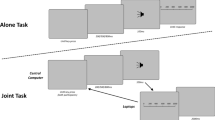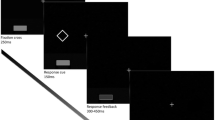Abstract
Intentional binding is the perceived shortening of the time between a voluntary action and its consequent effect and has been suggested as an implicit measure of agency. This shortening has been linked to processes underlying action preparation and is also affected by post-movement feedback. Intentional binding has been demonstrated in joint action tasks involving two humans, but it is unknown whether it occurs for tasks involving a human working alongside a non-human partner. This experiment investigated the influence of high-level feedback on the experience of agency and whether binding occurs in human–computer joint action settings. Participants were involved in two versions an action task involving another ‘agent’. In one version, two participants (a genuine participant and a confederate) sat side by side, separated by a curtain that prevented vision of the other person. In baseline conditions, both participants were instructed to make a self-paced action and judge the time of the action by reporting the position of a rotating clock-hand on a computer screen. In other baseline conditions, participants judged the time of an auditory tone. In operant conditions, participants made actions and the genuine participant’s action was followed 200 ms later by a tone on every trial. To examine the effect of post-movement information on binding and explicit agency judgments, a colour cue was presented on each trial informing participants about which person’s action caused the tone. In another version of the task, participants were paired with a computer instead of a human co-actor. Post-movement information affected the genuine participant’s explicit agency judgments but had no effect on intentional binding, which always occurred. In the human–computer version, participants never showed binding, even when they explicitly judged that their action had caused the tone. We suggest that human–human partnerships result in the formation of a new ‘we’ agentic identity, but that human–computer partnerships lead to inhibition of the processes that mediate the pre-reflective sense of agency.

Similar content being viewed by others
References
Atmaca S, Sebanz N, Prinz W, Knoblich G (2008) Action co-representation: The joint SNARC effect. Soc Neurosci Special Issue: Mirror Neuron Syst 3:410–420. doi:10.1080/17470910801900908
Balconi M (ed) (2010) Neuropsychology of the sense of agency: from consciousness to action. Springer, New York
Bratman ME (1992) Shared Cooperative Activity. Philos Rev 101:327–341
Buehner MJ, Humphreys GR (2009) Causal binding of actions to their effects. Psychol Sci 20(10):1221–1228. doi:10.1111/j.1467-9280.2009.02435.x
Carruthers G (2010) The case for the comparator model as an explanation of the sense of agency and its breakdowns. Conscious Cogn. doi:10.1016/j.concog.2010.08.005
Crivelli D, Balconi M (2010) Agency and inter-agency, action and joint action: Theoretical and neuropsychological evidence. In: Balconi M (ed) Neuropsychology of the sense of agency: From consciousness to action. Springer, New York, pp 107–122
David N, Newen A, Vogeley K (2008) The “sense of agency” and its underlying cognitive and neural mechanisms. Conscious Cogn 17:523–534. doi:10.1016/j.concog.2008.03.004
Ebert JP, Wegner DM (2010) Time warp: authorship shapes the perceived timing of actions and events. Conscious Cogn 19:481–489. doi:10.1016/j.concog.2009.10.002
Fadiga L, Fogassi L, Pavesi G, Rizzolatti G (1995) Motor facilitation during action observation: a magnetic stimulation study. J Neurophysiol 73(6):2608–2611
Haggard P, Clark S, Kalogeras J (2002) Voluntary action and conscious awareness. Nat Neurosci 5:382–385. doi:10.1038/nn827
Moore JW, Haggard P (2010) Intentional binding and higher order agency experience. Conscious Cogn 19:490–491. doi:10.1016/j.concog.2009.11.007
Moore JW, Lagnado D, Deal DC, Haggard P (2009) Feelings of control: contingency determines experience of action. Cognition 110:279–283. doi:10.1016/j.cognition.2008.11.006
Moore JW, Ruge D, Wenke D, Rothwell J, Haggard P (2010) Disrupting the experience of control in the human brain: pre-supplementary motor area contributes to the sense of agency. Proc Biol Sci 277:2503–2509. doi:10.1098/rspb.2010.0404
Nahab FB, Kundu P, Gallea C, Kakareka J, Pursley R, Pohida T et al (2011) The neural processes underlying self-agency. Cereb Cortex 21(1):48–55. doi:10.1093/cercor/bhq059
Pacherie E, Dokic J (2006) From mirror neurons to joint actions. Cogn Syst Res. Special Issue: Cogn Joint Act Collect Intent 7:101–112. doi:10.1016/j.cogsys.2005.11.012
Richardson MJ, Marsh KL, Isenhower RW, Goodman JR, Schmidt RC (2007) Rocking together: dynamics of intentional and unintentional interpersonal coordination. Hum Mov Sci 26:867–891. doi:10.1016/j.humov.2007.07.002
Rizzolatti G, Fadiga L, Gallese V, Fogassi L (1996) Premotor cortex and the recognition of motor actions. Brain Res Cogn Brain Res 3(2):131–141
Sato A (2009) Both motor prediction and conceptual congruency between preview and action-effect contribute to explicit judgment of agency. Cognition 110:74–83. doi:10.1016/j.cognition.2008.10.011
Searle JR (1980) The intentionality of intention and action. Cogn Sci: A Multidis J 4:47–70. doi:10.1207/s15516709cog0401_3
Sebanz N, Bekkering H, Knoblich G (2006) Joint action: bodies and minds moving together. Trends Cogn Sci (Regul Ed) 10:70–76. doi:10.1016/j.tics.2005.12.009ER
Seemann A (2009) Joint Agency: Intersubjectivity, sense of control and the feeling of trust. Inquiry 52:500–515
Strother L, House KA, Obhi SS (2010) Subjective agency and awareness of shared actions. Conscious Cogn 19:12–20. doi:10.1016/j.concog.2009.12.007
Synofzik M, Vosgerau G, Newen A (2008) I move, therefore I am: a new theoretical framework to investigate agency and ownership. Conscious Cogn 17:411–424. doi:10.1016/j.concog.2008.03.008
Tsakiris M, Haggard P (2003) Awareness of somatic events associated with a voluntary action. Exp Brain Res 149:439–446. doi:10.1007/s00221-003-1386-8
Wegner DM (2003) The mind’s best trick: How we experience conscious will. Trends Cogn Sci (Regul Ed) 7:65–69. doi:10.1016/S1364-6613(03)00002-0
Wegner DM, Wheatley T (1999) Apparent mental causation: Sources of the experience of will. Am Psychol 54:480–492. doi:10.1037/0003-066X.54.7.480
Wohlschlager A, Haggard P, Gesierich B, Prinz W (2003) The perceived onset time of self- and other-generated actions. Psychol Sci 14(6):586–591
Wolpert DM, Ghahramani Z, Jordan MI (1995) An internal model for sensorimotor integration. Science 269:1880–1882
Acknowledgments
This work was supported by an NSERC discovery grant and an Ontario Early Researcher Reward held by SSO.
Author information
Authors and Affiliations
Corresponding author
Additional information
Preston Hall is a co-first author on this paper.
Rights and permissions
About this article
Cite this article
Obhi, S.S., Hall, P. Sense of agency in joint action: influence of human and computer co-actors. Exp Brain Res 211, 663–670 (2011). https://doi.org/10.1007/s00221-011-2662-7
Received:
Accepted:
Published:
Issue Date:
DOI: https://doi.org/10.1007/s00221-011-2662-7




